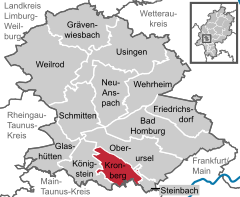Schönberg, Kronberg im Taunus
| Kronberg im Taunus | ||
|---|---|---|
|
||
| Coordinates: 50°11′N 8°30′E / 50.183°N 8.500°ECoordinates: 50°11′N 8°30′E / 50.183°N 8.500°E | ||
| Country | Germany | |
| State | Hesse | |
| Admin. region | Darmstadt | |
| District | Hochtaunuskreis | |
| Government | ||
| • Mayor | Klaus Temmen (Ind.) | |
| Area | ||
| • Total | 18.62 km2 (7.19 sq mi) | |
| Elevation | 200-400 m (−1,100 ft) | |
| Population (2015-12-31) | ||
| • Total | 18,330 | |
| • Density | 980/km2 (2,500/sq mi) | |
| Time zone | CET/CEST (UTC+1/+2) | |
| Postal codes | 61476 | |
| Dialling codes | 06173 | |
| Vehicle registration | HG | |
| Website | www.kronberg.de | |
Kronberg im Taunus is a town in the Hochtaunuskreis district, Hesse, Germany and part of the Frankfurt Rhein-Main urban area. Before 1866, it was in the Duchy of Nassau; in that year the whole Duchy was absorbed into Prussia. Kronberg lies at the foot of the Taunus, flanked in the north and southwest by forests. A mineral water spring also rises in the town.
Kronberg is especially known for its extremely expensive residential areas. It is therefore a very exclusive area to live and that is indicative of the higher than average incomes enjoyed by its population. The German magazine "der Spiegel" published a study showing that Kronberg had the most expensive residential areas in whole Germany.
Kronberg borders in the north and east on the town of Oberursel, in the southeast on the town of Steinbach, in the south on the towns of Eschborn and Schwalbach (both in Main-Taunus-Kreis), and in the west on the town of Königstein.
Kronberg consists of the three centres of Kronberg (8,108 inhabitants), Oberhöchstadt (6,363 inhabitants) and Schönberg (3,761 inhabitants).
When Kronberg Castle was built (about 1220) it was shared by the Knights of Askenburne (Eschborn), who owned a towered castle there. The Kronenstamm (stamm = stem) moved to Kronberg, giving themselves that name at the time, while the Flügelstamm ("wing stem") followed them there only 30 years later.
Town rights were granted the small settlement on 25 April 1330 by Louis IV, Holy Roman Emperor. As of 1367, the town also had market rights as well as Blutgerichtsbarkeit (meaning that there was an Imperial court authorized to mete out bodily punishment, including death), granted by Charles IV, Holy Roman Emperor. Together with those from Hattstein Castle and Reifenberg Castle, the Knights of Kronberg from Frankfurt declared the so-called "Kronberg Feud" in 1389. When on 13 May a great force from Frankfurt swept to Kronberg Castle, Hanau (Ulrich von Hanau) and the Electorate of the Palatinate (150 of Ruprecht von der Pfalz's cuirassiers) troops rushed to help those being beset, driving the Frankfurt forces off on 14 May in the Battle of Eschborn and taking 620 prisoners, among them the mayor, a few noble council members and all the town's bakers, butchers, locksmiths and shoemakers.
...
Wikipedia



